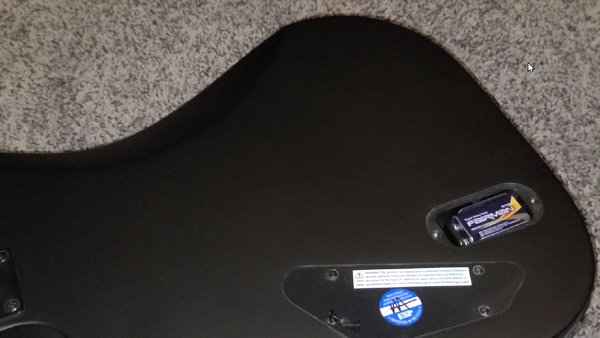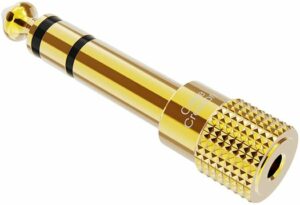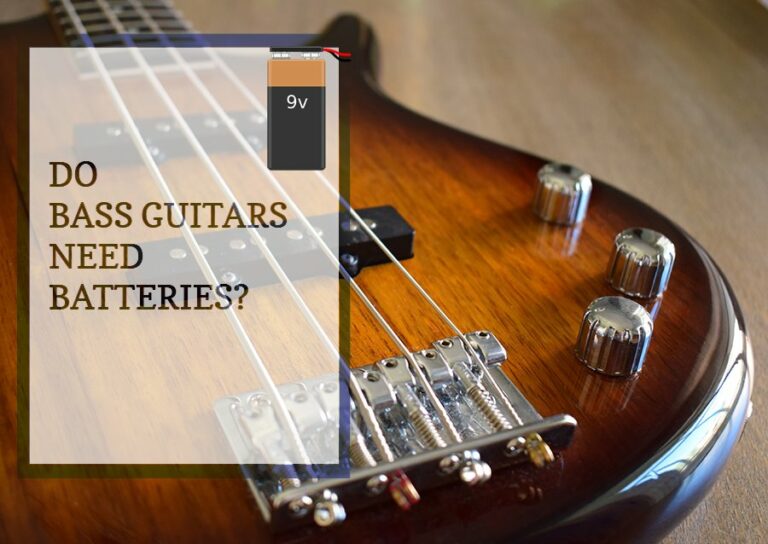Did you check out bass guitars in a store or online that had a battery compartment in the back? Well, what you found was an active bass guitar! These bass guitars have an “active” electronic circuit (or preamp) onboard the guitar that runs on 9-volt batteries. The other type of bass is the passive bass guitar which does not have such electronics.
Active bass guitars need a 9-volt (in some cases, 2 such batteries or 18-volts) to power the preamplifier on the bass. They also have EQ settings onboard, which allows better tone shaping fright from the guitar. Active bass guitars are considered by many to have a brighter, funkier sound and are popular among musicians in the metal and funk genres.
Before we dive into a detailed discussion on the working of bass guitars and how they may be better suited for you, let’s first look at the difference between active and passive bass guitars.
What Is an Active Bass Guitar, and How Are They Different from Passive Bass?

Active bass guitars have a preamp on the guitar itself which requires a power supply to run and gives far better control over the tone than passive guitars that do not need any power supply.
Many active bass guitars, though, will not have active pickups (pickups that also need a power supply to operate) and will have passive pickups with an “active” preamp. Some bass guitars will have a preamp as well as active pickups.
Passive bass guitars have simpler electronics where the signal coming from the pickups has a variable resistor connected in series. This simple setup is called a low-pass filter, and it can cut frequencies allowing the tone knob on the guitar to attenuate frequencies such as the high-end or the bass frequencies, depending on the user’s choice.
On the other hand, the electronics in active bass guitars allow you to both cut and boost frequencies. For example, you not only can cut the treble but also boost the bass frequency beyond what the signal contains and vice versa. Also, due to the battery, the signal from active bass guitars is much stronger than from passive bass guitars.
There are also many more differences between active and passive bass guitars, but we’ll be focusing more on the discussion on active bass guitars in this article.
The Advantages of Active Bass Guitars
An active bass’s primary advantages are that it offers more control over the tone and provides a cleaner, stronger signal. A stronger signal means the tone doesn’t suffer degradation and interference when using long cables.
A stronger signal could be advantageous in a live performance setting where the cables run hundreds of feet before hooking into the amp or the PA system. In the case of a passive bass, a longer cable run would mean a loss in both signal strength and quality. In such cases, the cable also starts to pick up many interferences from other electronic/electrical devices.
In such cases, the signal coming to the amp will be weak and require you to increase the volume and gain in the amp. Along with the noise in the signal, this would make the sound output far inferior.
And, as previously discussed, active bass offers better capabilities in terms of both attenuating and boosting frequencies. Most active basses have 2 or 3 or even more band EQs providing far better control over shaping the tone right from your bass, and this is very convenient when changing the EQ mid- or between performances. In a gig or live performance, this would mean you don’t have to ask the sound engineer for slight modifications to the tone.
As far as external noise and interferences are concerned, active bass also has the upper hand in this area. The electronic circuit allows active bass guitars to filter out noises and electromagnetic interferences to provide a cleaner signal.
The Disadvantages of Active Bass Guitars
Like everything on the face of this earth, active guitars also come with their fair share of drawbacks.
The first and foremost issue some people have with the active bass has to do with the sound or the tone. Some people do not like the less dynamic sound, which is a bit too bright and snappy. Passive bass guitars, on the other hand, have a warmer, rounder, and more natural tone. One is not objectively better than the other, however. It all depends on your preferences and the genre of music.
Also, anything that runs on batteries needs replacements too. Especially if you play a lot, you should always keep spare batteries when going for a gig. Remember, if you do not have a bass that can switch between active/passive, an active bass without a battery is like a bassist without a bass — it can’t be played.
The other issue you might face with active bass is that the stronger signal might not work optimally with some effect pedals. So, you’ll have to consider that, always check the manual when in doubt.
As far as price is concerned, active bass guitars are generally more expensive than passive bass due to the additional electronics fitted into the guitar, which is quite obvious. Although, you can find cheap active bass just as easily as you can find expensive passive bass.
Sound/Tone of Active Bass Guitars
Active bass guitars innately have a distinct “bright” and “funky” tone more suited for certain music styles and genres. The electronic circuit in these guitars can filter out noise and interferences, but on the flip side, they also reduce the dynamic range of the sound and even distort it to some degree. Some people like this clear, somewhat filtered, slightly unnatural tone, and others do not. It all depends on your music style and what you’re looking for in your music.
With the ability to shape the tone with EQ, you have better control over boosting or cutting specific frequencies. For example, make the sound more treble-forward by boosting the high-end frequencies or more bass-forward and thumpy by augmenting the low-end frequencies. This way, the bass guitar has more power over the tone and can create a distinct sound. Please note that this can also be done with passive bass using the EQ controls on the amp. However, the sound output would still be slightly different in many cases.
At the risk of stating the obvious, the stronger signal will also mean the sound would be louder with a lower gain and volume set in the amp. A lower gain generally means a clearer overall sound output.
So, for the most part, the sound of an active bass will be different from that of a passive one. You’ll have to try it out for yourself to see if you like it or not.
Active Guitar with Active Pickups
As we have learned, most active bass nowadays come with passive pickups. The sound produced in the case of an active guitar with active pickups will again be slightly different than standard active guitars. To understand the underlying reason for this, let’s have a simplified explanation of how pickups work.
A pickup is a device containing an electromagnetic arrangement of a long thin wire wound around a magnet that produces an electric current when the strings near it vibrate. Passive guitars produce a signal by picking up the strings’ vibration this way, which is then fed to the amp.
In the case of an active pickup, a slightly different setup of a weaker magnet is used to reduce noise and interference from getting picked up, but this, in turn, gives out a feeble signal output. This weaker signal is boosted with the power supply (in simple terms) before being fed to the onboard active preamp. This process makes the tone subtly clearer, sharper, and more hi-fi than regular active bass, again preferred by some people, especially in the modern metal genre.
Active-Passive Switchable Bass Guitar
If you’re someone that likes the sound of both passive and active bass, there is yet another option — the active/passive switchable bass.
As the name suggests, these bass guitars have a switch that turns the active mode on or off. When the switch is turned on, you get the active capabilities of the bass, while the passive mode ensures you can play it even without a battery in case it has run out.
Though more expensive in general, these bass guitars are suitable for someone who likes a wide genre of music and like experimenting with their tone.
Can I Plug a Headphone Directly into an Active Bass?
Active bass has an electronic circuit providing a higher signal level. The question arises — can you plug in headphones directly to the bass guitar for practicing?
The answer is — you might be able to with certain active bass guitars. The higher signal level means, in many cases, it would be able to drive a headphone, but even if it does work, it won’t sound good or anything like it should when plugged into an amp (or a headphone amp). Also, you’ll need a 1/8th inch to 1/4th inch adapter since almost all headphones have a 1/8th inch jack.

The reason for the bad quality sound is the impedance-mismatch. Active bass guitars have a much higher impedance than what regular headphones handle, making them unsuitable though technically still able to produce sound at low levels.
This ability could come in handy in case you want to practice and don’t have an amp of any sort. But, if you wish to get a feel of the “real” sound output, you’ll have to get yourself atleast a headphone amp. These are pretty cheap, and for someone who likes to practice quietly, the headphone amps can be one of the best early investments.
Final Thoughts
Often described as “bright” and “snappy,” the sound of an active bass is something that suits some people more than others. Musicians in the metal genre generally find the sound suitable for their style. Also, someone recording in a studio may prefer an active bass for its clearer and noise-free sound output.
An active bass guitar will provide much more control over your tone if you are someone that plays varied genres or wants complete control over your tone. If you’re a fan of metal music and it is something that you mostly play, you can even go for an active bass with active pickups to have a cleaner, snappier sound.
I hope this article clarified some of your doubts regarding the use of batteries in bass guitars and how that affects not only the way the instrument works but also how it sounds.
Photo credits:
- Active Bass Guitar Back Side Picture by Saki Bass Player


